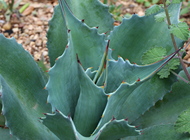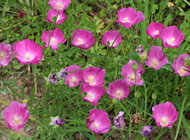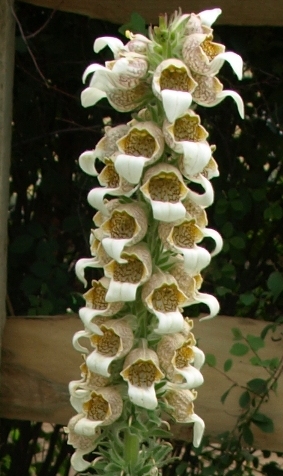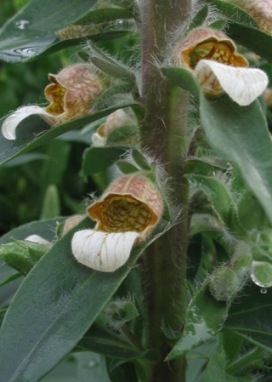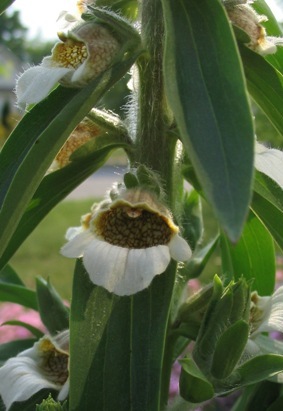The genus digitalis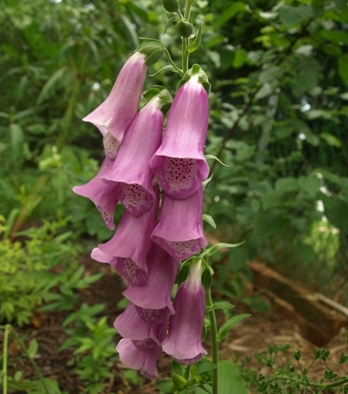
Digitalis is a genus of a couple dozen or so species (wikipedia says about 20, GRIN lists only about 12 currently accepted species). As a group, they are known as the foxgloves, named for their most popular species, the common foxglove: Digitalis purpurea. The genus has recently migrated from the figwort family (scrophulariaceae) to the plantain family (plantaginaceae) – along with its cousins the penstemons – but most references still place them in their former taxonomical position. Common foxglove is a deservedly popular biennial species, famous for its self-sowing habits in cottage gardens. Many cultivars in different habits and colors have been developed, and are featured proudly in lush photographs of English cottage gardens. Another claim to fame for the genus are the chemicals (called digitalins) which have medicinal value when used judiciously, but render all parts of the plant poisonous when consumed by mammals and humans and other mammals. Other references can tell you more details about how these chemicals inhibit, attack, and affect the various organs; I'll leave it at "just don't eat 'm!". The "other" digitalis speciesAlthough I've grown a few varieties of D. purpurea through the years, they've never done as well for me as I hoped (based on the glorious pictures in garden magazines and on seed packets), and for some reason they never once self-seeded. So common foxglove doesn't figure very strongly in our garden – but that is counter-balanced by a much greater emphasis on its less frequently grown cousins. The "other" digitalis species are typically listed as perennials, even though some are certainly more long-lived in our garden than others. There's a good deal of confusion in online references and among seed suppliers and traders as to the proper identification and nomenclature of these various species; and when confusion sets in, I often resort to a web page comparing and contrasting the various plants we've grown, to see if I can make better sense of it all. So on the rest of this page you'll find my comments and photos of several digitalis species. Some of them are "official" species recognized by GRIN and other references, while others came to me from nurseries and seed trades with less well-established names. Any insights you may have on disentangling the taxonomy would be welcome – I invite you to use the comment form at the bottom of this page for this purpose. Each of the species shown on this page also has its own plant portrait page on this website, usually with larger and different photographs. Click on the linked botanical names to access these portrait pages. Cultivation and propagationIn my experience, most digitalis are pretty rugged plants. Some do fine with full sun in our Pennsylvania garden, but most of them appreciate at least part day shade, and I know of none that insist on all-day sun. The ones that appreciate some shade also tend to be a little less tolerant of dry conditions, but some supplemental water through dry spells is usually enough to bring them through summer. As a group they are also quite hardy, some species surviving as far north as USDA zone 2, others at least good to zone 5 or 6. Due to their toxicity, foxgloves are generally regarded as resistant to rabbits and deer. A few species have behaved like true perennials in our garden: D. lutea and D. grandiflora being two prime examples. Others act more like biennials, or may eke out a third year of performance before fading away. So I try to collect seed for the species I appreciate – which luckily they all set in abundance. I've never divided a digitalis - they grow from non-spreading rosettes, so they don't invite division, although I suspect that some species can indeed be multiplied that way. But all of my propagation goes through seed. They are easy to germinate: most species require no special attention besides exposure to some light in order to sprout. Germination usually occurs within two weeks of sowing. Details of my seed-starting trials are given on each of the individual plant portraits linked from this page. Because they grow slowly in their first year, I start my Digitalis in February, growing the seedlings on in pots or cell-packs under fluorescent lights in the basement. Even as seedlings they can stand some light frost, so they go outside already in early spring to harden off. By mid-late April, they are ready to be planted out in the garden, where they will spend their first year growing into a sturdy rosette of low-growing leaves. The following year, they will reach skyward, sending a leafy stalk with flowers along its upper reaches to heights ranging from one foot (D. thapsi) to four feet or more (D. ferruginea, among others). The species in our gardenDigitalis × mertonensis – plump and rosy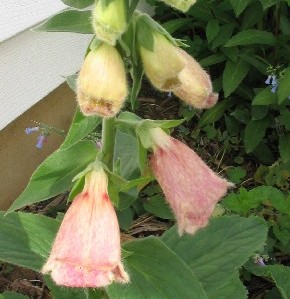
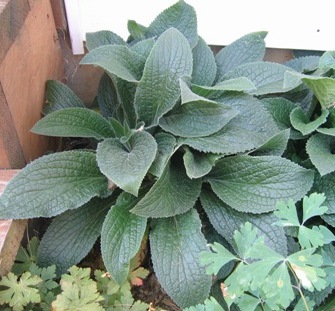
Strawberry foxglove is only half a step away from D. purpurea: it is a hybrid between common foxglove and yellow foxglove (D. grandiflora). It has handsome deep green crinkly leaves, with short stalks carrying soft-hairy muted rosy pink flowers. According to some references, it is more perennial than common foxglove, but that must only apply to gardeners with just the right climate: I have only ever enjoyed its flowers on second-year plants, no return in year three. It's been a few years now since I last tried – maybe I'll try to coax it into behaving like a perennial one last time (deadheading may help; I seldom deadhead, because it means giving up those precious seeds). Digitalis thapsi – sleek in pink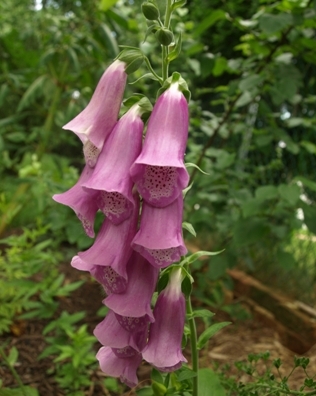
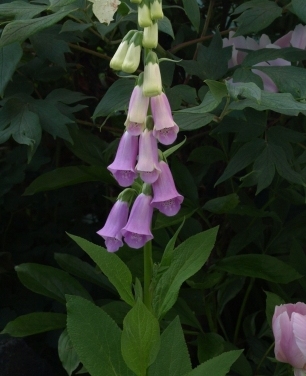
Continuing with the brightly colored species, this is a pretty one from the Mediterranean with smooth demurely pink flowers carried on one side of the upright flowerstalk. The true species stays low (no more than two feet tall), although through some garden promiscuity in action I've found taller specimens in our garden. The little ones are the nicest, I think. The leaves are mid-green and crinkly, broader than those of many other foxgloves. A popular cultivar is 'Spanish Peaks' – in fact, my plants may be offspring of that cultivar for all I know. Digitalis obscura – blushing yellow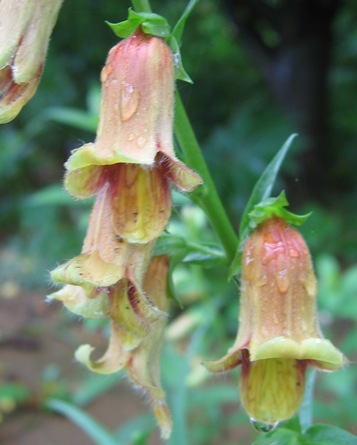
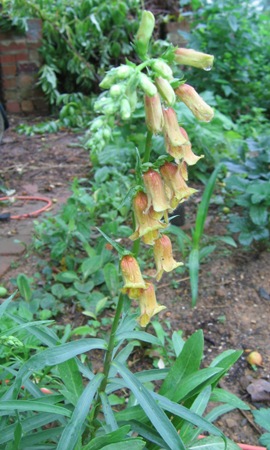
Willow-leaf foxglove, as its name suggests, has the narrowest leaves of the species I've grown. It does not form as much of a rosette as its cousins, instead holding most of its leaves in an alternating pattern along the lower half of the flowerstalks. The leaves are somewhat evergreen, although they tend to look quite dilapidated by the end of the cold season. The other common name, dusky foxglove, derives from the flowers, which are intriguingly colored, with red markings somewhere between a blush and streaks overlaying a yellow background. They are larger than average, and face downward. The stalks are not as sturdily upright, preferring to grow in a curvaceous fashion to about 2 feet tall. Digitalis grandiflora – the clearest yellow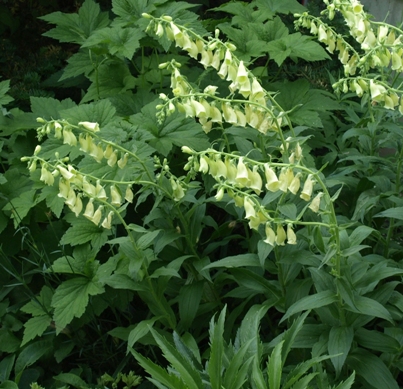
Now we're sliding into the yellow end of the color spectrum; while yellow is featured in many Digitalis species, this is the clearest one of the bunch, with larger pure pale yellow flowers; its common name is even "yellow foxglove". The leaves on this plant are narrower, ending in a pointy tip; they are soft- hairy, which gives them a dullish mid-green appearance: a good foil for the masses of flower spikes (some upright, some nodding) that appear in late spring. A reliable perennial, this is for sure one of my favorite foxgloves. In our garden it reseeds occasionally, but certainly not rampantly. Digitalis lutea – creamy abundance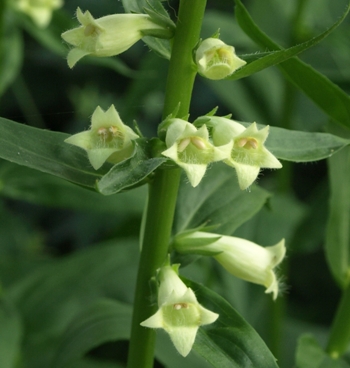
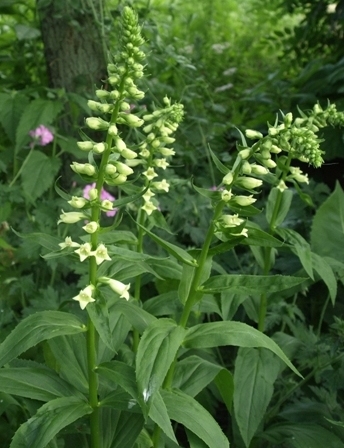
Another entry into the yellowish end of things, straw foxglove has smaller flowers than D. grandiflora, in a luscious buttery shade. Each stalk holds dozens of flowers, neatly spaced, each perfectly formed into a narrow tube opening to a mouth with a broad lower lip and a two-peaked upper lip. The leaves are strap-shaped, pointy, and smoother than those of the species above, in a darker shade of green. Straw foxgloves in bloom look spendid in a partly shaded area, where the flowers really pop. We grew ours in mostly shaded areas for years, until some of them escaped and surprised me by doing quite well in mostly sunny parts of the garden. They happily seed themselves around, only occasionally making a nuisance of themselves. Each plant lasts for a good number of years. All in all, a standby in the Lush Gardens. Digitalis fontanesii – a net of red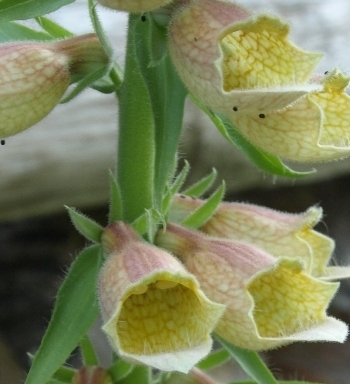
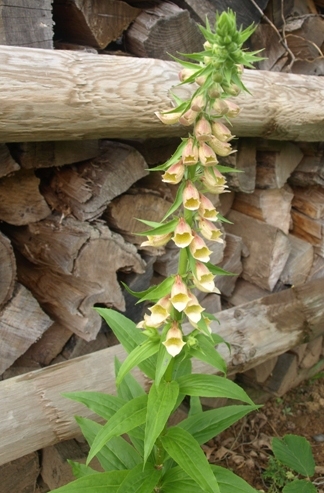
And now we come to the first of the botanically muddled varieties on this page. There are not many references to this species online; a search on GRIN brings up a page that says it's a synonym for Digitaria, which is clearly false (since that is a genus of grasses). But there are enough mentions of the species that I'll continue referring to it by this name until somebody convinces me it's something else. The leaves on this one are somewhat narrow and pointed. I grew my plants from seed, but for some reason have not been able to collect any viable seed from them – which is quite unusual for a foxglove. Digitalis parviflora – for the love of chocolate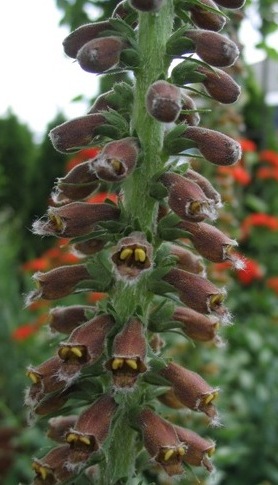
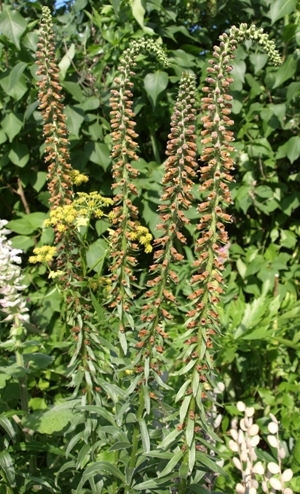
The upright or slightly curving flowerstalks of the species are clothed in an abundance of small flowers, each with a tuft of silvery hair attached to its lower lip. I find the overall effect, when viewed up close, to be comical. The flowers on ours are a rich chocolaty brown. Other photos of the species sport some different color variations, including even redder tints, and some lighter shades of orange. I'm pretty happy with our strain, which I need to start from seed regularly, because the plants are short-lived and do not self-sow in our garden. Even though these plants, at about two feet height, are taller than most front-of-the-border perennials, they are narrow enough to go close to the front. That way their flowers, which can appear washed-out from a distance, can be appreciated up close. Digitalis ferruginea – stately and rusty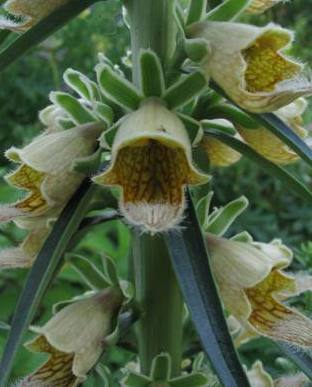
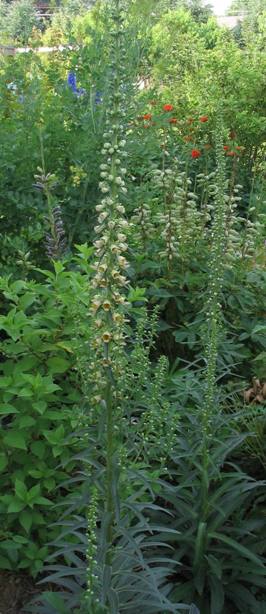
We have now arrived squarely in the digitalis zone characterized by muted earth tones – soft yellow, brown, and ochre figure prominently in many species. Rusty foxglove features reddish-brown coloration in its netted-interior flowers, which are arranged in abundance along tall, upright spires. It's a rather easy-going perennial; individual specimens are not particularly long-lived for us, but they do self-seed to keep themselves represented in our garden. The leaves are darker green and narrow, climbing up the flower stalk to a fine Christmas tree effect. There are several named cultivars, including 'Gigantea' (which of course grows particularly tall), and 'Gelber Herold', which has a more pronounced yellow coloration. I'm pretty sure that whatever is growing in our garden at the moment is either the plain species, or a bastard involving another species or two. Which is unavoidable in a smallish garden featuring multiple digitalis varieties. A woolly complex of other creamy browny yellowy speciesI've grown several other forms and varieties of digitalis through the years. They usually came from seed trades (but sometimes from nursery purchases), and were named D. lanata, D. lamarckii, and D. laevigata. The plants are similar, with mostly upright stalks bearing strap-shaped leaves and flowers with a creamy lower lip and a brown-netted interior, with varying degrees of hairiness and floral density along the stalk, and ranging in height from two to four feet. A botanist visitor to my website commented in an email about one of the varieties I had put up that it belonged to the "Digitalis lanata complex". So if even the scientists have a hard time keeping the various similar species/subspecies/varieties apart, who am I to try to bring order to the subject? All of these are attractive in an understated way, and none have proven to be long-lived in our garden. The captions for the photos shown here are the names under which they came to our garden – I'm not suggesting they are correct.
Other speciesI've attempted to grow D. viridiflora from traded seed, but found myself with a pretty variety of D. lutea instead. The real species, native to southeastern Europe, would be worth growing as well – maybe I'll track it down one of these days. I have also tried to obtain D. trojana; my attempts to grow the seed labeled as such have not been successful, but in fact some of my plants in the lanata complex may have been this species. I'll be trying again soon. Other species recognized by GRIN include D. mariana and D. nervosa, as well as a few that are synonyms for species now included in Rehmannia and Isoplexis. I figure I'll have an opportunity to try a few of these, as seed becomes available through seed trades and society exchanges. Do let me know if you grow any distinct species not included on this page: I'd love to grow as many as I can, at least once! Visitors to this page have left the following comments
I welcome comments about my web pages; feel free to use the form below to leave feedback about this particular page. For the benefit of other visitors to these pages, I will list any relevant comments you leave, and if appropriate, I will update my page to correct mis-information. Note that I discard any comments including html markups, so please submit your comment as plain text. If you have a comment about the website as a whole, please leave it in my guestbook. If you have a question that needs a personal response, please e-mail me.
Last modified:
March 04, 2012 |
|||||||||||||||||||||||||||||||||||||||||||||
